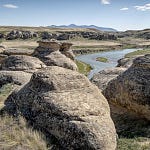I'm thinking of two uses of language: to dismiss, and to go deeper.
Using Words to Dismiss
I have a friend who is an older man with a great sense of humour. I’d bring up someone in conversation and ask if he knew them, like, ‘Do you know Maria?’
‘Maria, Maria… Hmmm.’
‘You know, crazy Maria.’
‘Ah yes, crazy Maria!’
He’s taking that whole phenomenon that is Maria and boiling down into one little word, crazy. Then we can stick her on the shelf and not think too hard about the reasons behind what she has said or done.
This is how racism and sexism work. ‘Oh, she’s just a woman.’ And, ‘That’s typical of immigrants.’
Using Words to Go Deeper
The other way to use words is the opposite: to enter more deeply into a person or subject. In this case, words bring us into complexity and specificity.
Here’s an example. Recently, I was on a forest walk here in the Pacific Northwest. I was guided by a friend of mine who is keenly interested in the fungi, moss and lichen living in this temperate rainforest. Alone I tend to stride through this forest, lost in my thoughts, but this time was different.
I'd never taken a slower walk. Or a more interesting walk. At every step, he pointed out varieties of fungus growing on the trees or on the ground: squat one and pointy ones, squishy ones and snotty ones; as well as lichen with blurred borders between shades of ochre and olive; and moss ranging from bristly to elongated. All the while, my friend was naming them, either with common terms or with words he’d made up.
Walking with him, I was able to enter into the wondrous variety of this forest. What’s the difference between a turkey tail mushroom, a lion's mane, and an artist’s conk? What's the difference between an aspen, a birch, and an aldar?
There's a great book by Robert MacFarlane, a British nature writer, called landmarks. It has glossaries of words woven into particular landscapes. There's a list of dialectical words about swampy landscapes, illuminating varied the conditions and dryness of peat moss, certain kinds of boggy soil, how trees look when they're lit by sunlight filtered through fog, and the the sorts of fog that you find only in swampy regions.
If I'm a newcomer, learning these words will help me to notice the textures of the place. These are words that live alongside the people living in those lands. They are use-language, a membrane linking human to land.
What We Allow to be Real
Names can help us notice details, if we use them right, yet those same names could be used to dismiss. ‘Turkey tail; check. Moving on.’ The illusion of knowing that being may keep us from looking closer into what we don’t know.
Words can help us notice the nuances of our planet, and also big concepts. Take the word ontology: as one guest on our podcast said, this is ‘what we allow to be real.’
This word encapsulates how every person, and every group of people, has a subjective world-view that includes a sense of where reality came from, what’s running it, and how we know. All that in one word.
When we encounter someone new, we can now wonder, what is their ontology? What is their worldview? What are the givens that inform what they say and do?
Here’s another word that invites big thinking: epistemology. How do we know what we know?On what basis do we consider it to be true?
Learning this word brings us into an understanding that everyone is sourcing their reality from somewhere. Which isn’t to say it’s not real.
So, words can be used to obscure, to oversimplify, to put experiences on a shelf so we can forget about them. But they can also be used to help us notice the details within something that was vague before, to help us notice what we may have otherwise overlooked.
Using Stories to Dismiss
Like words, stories can be used to dismiss, or to enter into another worldview.
What's an example of using a story to dismiss? Let’s say I'm dismissive of everything young people have to say. A teenager comes to me with something that could be a helpful insight, but they come up against my hand. ‘Wait until you’re older before you start giving me advice.’
And I’ve got a little story to shore up my conviction. ‘Look at this study of a kid’s brain compared to an adult’s brain. It shows the whole thing.’
My story is just sufficient to write off anything this teenager has to tell me. Zooming out, we see that these kinds of half-baked stories are used to dismiss people with particular skin colours, genders, ages, professions, species—you name it.
As a side note, traditional cultures tend to value elders far more than modern culture, but they also value the wisdom of the young.
Using Stories to Go Deeper
Like words, stories can bring us into the experience of others.
I'm reading a book now called A girl is a Body of Water, about a young girl growing up in Uganda. I am neither a young girl, nor have I been to Uganda, but I’m gaining some insight into that experience. Now, instead of thinking of Uganda as a country somewhere in Africa that I don't know much about, I’ve got a sense of life that. That spot in my worldview is gaining detail. This book is filling out my experience of the world, I'm able to perceive what I wouldn't have known to look for.
Listen to this episode with a 7-day free trial
Subscribe to Story Paths Sketchbook with Theo Lowry to listen to this post and get 7 days of free access to the full post archives.













